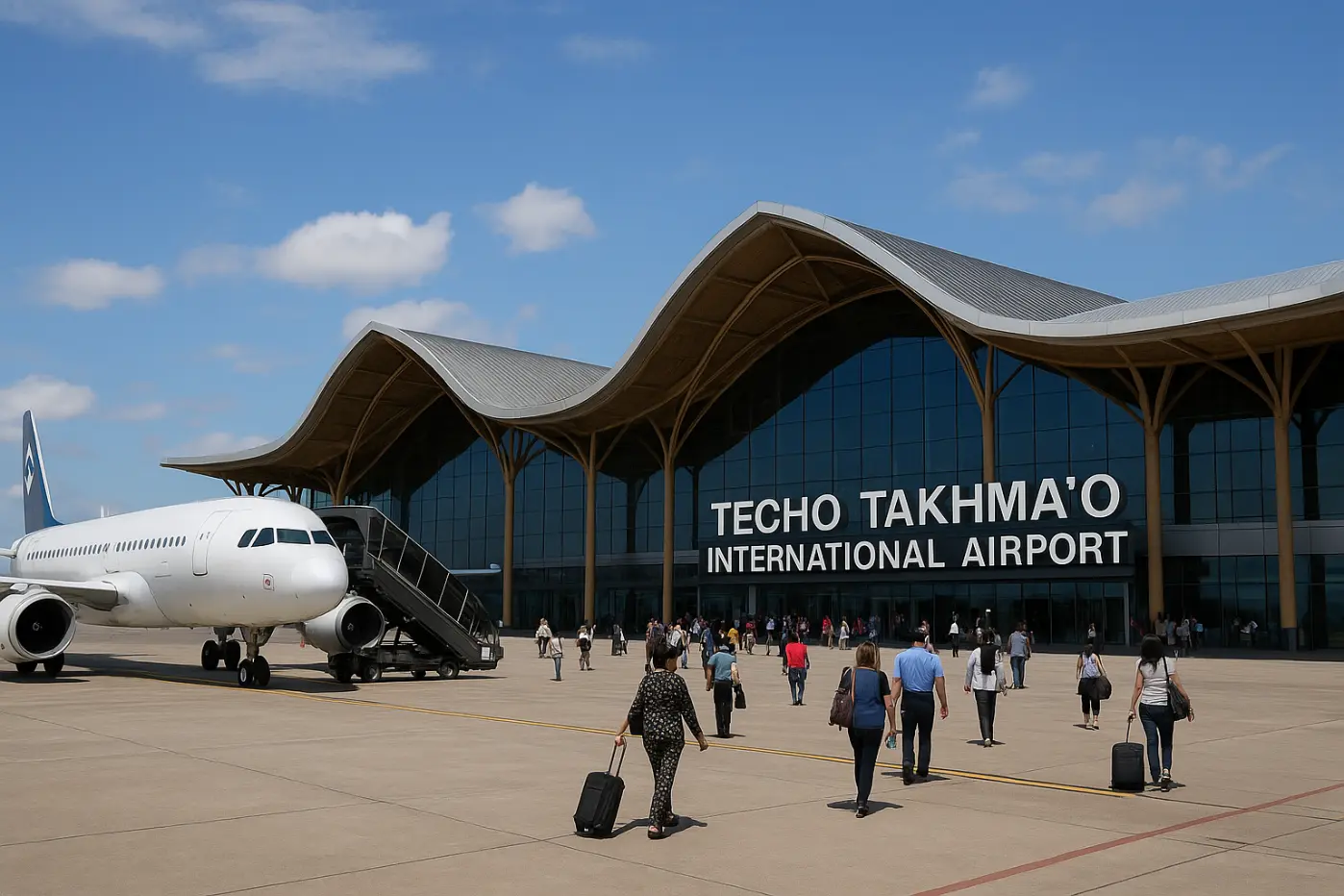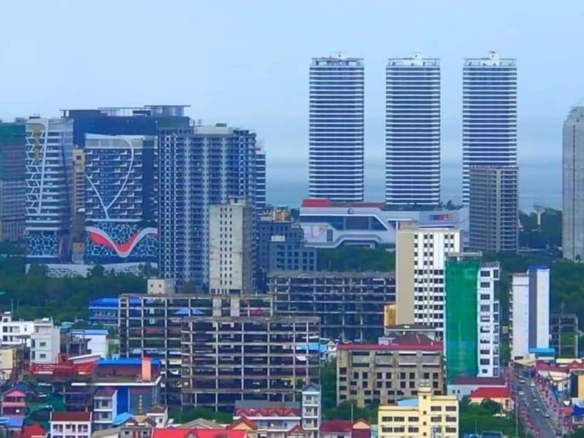Phnom Penh – Fire trucks erupted in a triumphant water salute as the inaugural Air Cambodia flight from China taxied into the gleaming new Techo Takhmao International Airport on September 9, 2025. For Cambodia’s aviation sector, long constrained by a single-runway capital airport, the opening of this $2 billion, three-runway facility felt like a coming-of-age. “The opening is a major step for Cambodia’s aviation and economy,” former Prime Minister Hun Sen crowed on social media, even as a first-time passenger from Singapore gushed, “it looks absolutely amazing”. With a first-phase capacity of 13 million passengers – more than double the old airport’s volume – and plans to expand to 30 million by 2030 (and eventually 50 million by 2050), Techo Airport has vaulted Cambodia into a new league. Meanwhile, in the north, the Chinese-funded Siem Reap–Angkor International Airport, opened in late 2023, now handles 7 million passengers annually with room to grow to 12 million by 2040. Combined, these projects more than double the kingdom’s air travel capacity, promising an unprecedented 142% jump from today’s limits.
Built 30–40 kilometers south of Phnom Penh, Techo Airport sprawls across 2,600 hectares of reclaimed farmland. Its immense terminal – designed by Foster + Partners – features soaring, Apsara-inspired bamboo-domed ceilings and even a nine-meter Buddha statue in Abhayamudra pose to “symbolize peace and protection for travelers”. Developed by Cambodia Airport Investment Company (CAIC) – a 90/10 joint venture between real-estate titan OCIC and the state aviation authority – Techo is slated to begin commercial operations with 13 million seats a year in Phase 1. Over the next decade, concentric terminal “wings” will raise capacity to 30 million, and a third phase could bring it near 45–50 million by 2050. The aging old Phnom Penh airport (built in 1950s) will be relegated to military and local traffic, its single runway retained only for emergencies. As OCIC Chairman Pung Kheav Se puts it: “Welcoming the first passengers at Techo International Airport is a defining moment… It creates new opportunities for Cambodia – for visitors, businesses, and investors – and marks the beginning of a new chapter for our country.”
The Siem Reap–Angkor airport, by contrast, is a Chinese-built build-operate-transfer project aimed squarely at temple tourism. Inaugurated in November 2023 by Prime Minister Hun Manet, it replaced an overburdened post-war landing strip near Angkor Wat. Its massive runway and terminal now handle about 7 million travelers a year, with expansion to 12 million slated by 2040 under a 55-year BOT deal with China. As one tourist lining up for the first departures remarked, the new terminal “looks absolutely amazing” – a far cry from the dusty apron of the old airport.
New Airlines, New Routes
The new airports have prompted a flood of fresh routes. In 2024 Cambodian skies saw only a handful of major carriers, but by 2025 dozens of international airlines were eyeing the market. Emirates began flying Dubai–Siem Reap (via Bangkok) in June 2025, and Turkish Airlines launched Istanbul–Phnom Penh service in December 2025. The capital’s Techo Airport also attracted attention: EVA Air promptly announced its Phnom Penh flights would switch from the old field to Techo on opening day. Domestic flag carrier Air Cambodia has likewise expanded; it inaugurated nonstop links between Siem Reap, Phnom Penh and secondary Chinese hubs like Shenzhen this summer. Industry analysts expect Cambodia to see roughly 31,600 flights in 2025 – a 14.2% jump over 2024 – as the network grows.
In short, Cambodia is shifting from long being an aviation laggard into a regional contender. Only a few years ago its two airports could barely manage 10 million combined passengers; now the first phase of Techo and the new Siem Reap field alone boost that to over 20 million (before the expanded second-phase capacities kick in). By comparison, Thailand and Vietnam have spent decades building huge hubs (Suvarnabhumi and Don Mueang in Bangkok, and the under-construction Long Thanh near Ho Chi Minh City) that handled tens of millions pre-pandemic. But with Techo and Siem Reap–Angkor, Cambodia is catching up fast – “an emerging aviation hub in Southeast Asia,” as one observer put it.
Economic Lift and Job Creation
Cambodia’s airport drive has been billed as an economic game-changer. “The airport’s construction is expected to significantly boost Cambodia’s connectivity and economic growth,” CAIC officials declared at the opening. They point out that beyond tourism it will spur logistics, trade and industry. The new facilities include expansive cargo areas and maintenance centers, allowing the country to export more goods by air. Analysts note that every $1 billion invested in aviation infrastructure typically generates thousands of new jobs – from construction workers to airport staff to hotel and retail employees. A recent economic study predicts Techo alone could directly create tens of thousands of jobs in the next decade through construction and airport operations. Cambodia’s Chamber of Commerce Vice-President Lim Heng foresees an entire industrial zone rising nearby: plans are already in place for a Special Economic Zone adjacent to the airport, “expected to evolve into a major investment corridor, creating abundant opportunities for business growth”.
Construction of Techo has indeed injected capital into the economy. Cambodia Airport Investment Co. floated a $379 million bond program in 2024 (backed by local banks and investors) and even attracted a $100 million investment from Thai oil giant PTT to fund an on‑site refueling depot. By the time of opening, the price tag had climbed from the original $1.5 billion estimate to roughly $2 billion. Still, government and private backers see it as worth the expense. OCIC has spent the past 25 years reshaping Phnom Penh’s skyline, and Techo is its boldest venture yet. OCIC’s Pung Kheav Se calls it “Techo International Airport represents the next step in Cambodia’s journey, underscoring our commitment to positioning the country as a regional hub for investment, travel and trade.”. Foreign partners also boost confidence: French group VINCI Airports was tapped to run operations, and British and Singaporean firms were hired to design and manage passenger flow, ensuring Western standards.
Real Estate Boom
Wherever the runways are laid, new property ventures follow. Already along Phnom Penh’s newly widened Samdech Techo Hun Sen Boulevard – the main link to Techo Airport – luxury condos, office towers and retail malls are under development. Market analysts note that speculators have snapped up land in Kandal province, anticipating a surge in demand for housing and logistics parks. Cambodia Property magazine reports “high-rise buildings, retail centers, banks, and residential complexes are transforming the corridor into a vibrant commercial hub”. In the decade ahead, planners expect dozens of hotels, apartment complexes and industrial parks to sprout around the airport districts. Similar effects are seen near Siem Reap: land prices around the Angkor airport and the city’s outskirts are on the rise, as tour operators and developers rush to build branded hotels and entertainment zones for incoming travelers.
This real estate dynamism has a human face. Small businesses – from car rentals to street-food vendors – are repositioning near the new terminals. Phnom Penh taxi driver Sok Sophorn says business has already picked up: “Before, tourists landed in the city center and stayed near Riverside. Now we’re the drivers of Phnom Penh’s airport,” he laughs. Local developers likewise see riches ahead. An executive at a Japanese investment firm noted that the Techo project is part of a larger vision: similar mega-projects (highways, express trains and SEZs) are planned to tie the airport to neighboring Vietnam and the Sihanoukville port, potentially turning this part of Cambodia into an industrial hub.
Tourism and Infrastructure
The timing couldn’t be better for Cambodia’s tourism. In 2024 the country received about 6.7 million international visitors – a 23% jump from the previous year – driven largely by Chinese and Southeast Asian holidaymakers. Officials hope the new capacity will accelerate that rebound. “With these airports, Cambodia becomes a true travel destination,” says Chhay Sivlin, president of the country’s travel agents’ association. He notes that the modern terminals “elevate Cambodia’s tourism profile, drawing attention to the nation’s cultural richness”. The logic is clear: more and larger airports mean more direct flights from long-haul markets. Hoteliers report already getting inquiries from cruise and tour operators in Europe and the Middle East who had previously ignored Cambodia as hard to reach.
Improvements to roads, rail and utilities are rolling out in tandem. Techo Airport will be connected to Phnom Penh by a new 60-meter-wide highway, including an 11.7 km stretch with bridges over two canals. Plans are even on the drawing board for an elevated rapid rail link to the capital’s metro network. All major power and water lines are being upgraded: OCIC is building a dedicated solar farm on site to supply Techo’s electricity needs. Likewise near Siem Reap, Chinese contractors have already widened highways leading to the Angkor airport and upgraded local water treatment systems to serve the influx of tourists. In effect, the airports are anchors for a wider infrastructure push: Cambodia has one eye on joining the East-West economic corridor, which would link its new airports through Laos to Vietnam.
Regional Context
Cambodia’s aviation ambitions put it among Asia’s fast-growers, if still trailing its neighbors. In absolute numbers, it has far fewer passengers than Thailand or Vietnam – countries which long ago built mega-hubs for tens of millions – but the pace of investment is striking. Before Techo, Cambodia’s international arrivals were a fraction of Thailand’s (where 70+ million foreign tourists landed in 2019) or Vietnam’s (18 million in 2019). Now, as Hun Sen noted, even a mid-sized new airport in Phnom Penh “boost[s] tourism” just by modernizing Phnom Penh’s image. Cambodia Air Minister Thong Khon likens it to a “catch-up sprint” – infrastructure-wise, the country is coming from behind, but it has moved quickly.
Economists caution that airports alone won’t guarantee prosperity – Cambodia still needs stable politics, transparent governance and airline connectivity. Indeed, recent border skirmishes with Thailand briefly clouded the optimism (a number of flights were diverted). But for now, the mood is upbeat. On the day of Techo’s opening, one veteran tourism executive summed it up: “We have built a gateway. Now the challenge is to fill it.” Around him, the bustling new terminal seemed to answer with a silent promise – the runway to growth has just gotten longer.
Sources: Official statements and news reports were used throughout, including Associated Press and Xinhua coverage of the airport openings, industry analysis of Techo’s financing, local business reports, and quotes from Cambodian officials and experts. All factual claims are drawn from these sources.





Join The Discussion